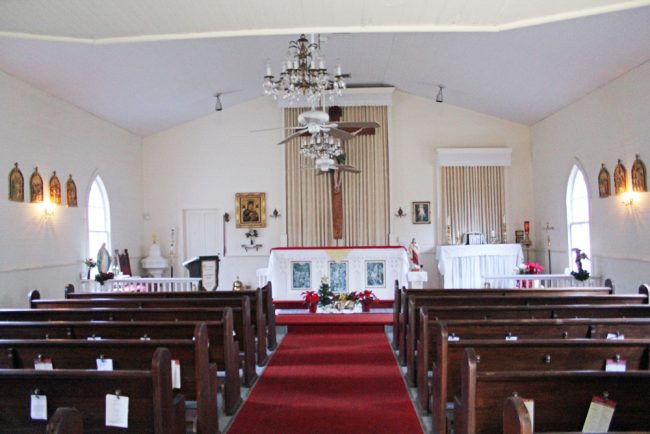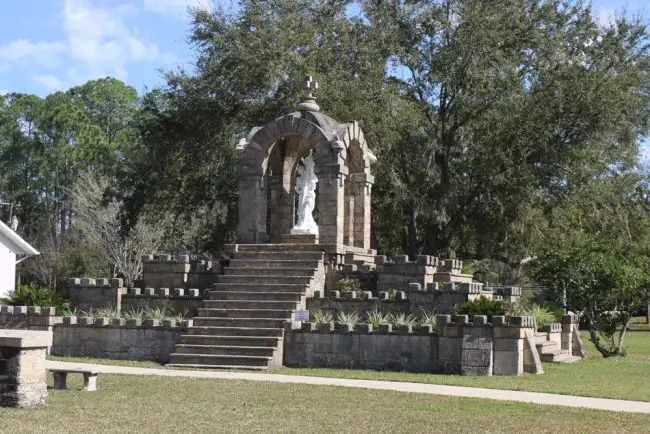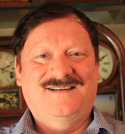
By Randy Jaye
The community of Korona’s St. Mary Catholic Church (also known as the St. Mary Mother Church) at 89 St. Mary’s Place in Bunnell was listed on the National Register of Historic Places (NRHP) on Jan. 25. The structure meets several NRHP requirements for historic significance including: architecture, ethnic heritage (European, Polish), and exploration/settlement. The very unique Shrine of Saint Christopher, a short distance north of the church, was also listed as a contributing resource.
The NRHP is defined by the National Park Service as “the official list of the nation’s historic places worthy of preservation. Authorized by the National Historic Preservation Act of 1966, the NRHP is part of a national program to coordinate and support public and private efforts to identify, evaluate, and protect America’s historic and archeological resources.”
I began the NRHP research and nomination activities almost seven years ago. Several issues including red tape at the Catholic Diocese of St. Augustine and the Covid pandemic caused significant delays. The St. Mary Catholic Church’s NRHP listing can surely be associated to the old and popular saying: “Good things come to those who wait.”
The St. Mary Catholic Church’s listing increases the number of Flagler County properties on the NRHP to 13. I researched and successfully nominated the previous four Flagler County listings: Espanola School House (2020), Bunnell Coquina City Hall (2019), Bunnell Water Tower (2019), and the Holden House (2018).
Flagler County was founded in 1917 from parts of Volusia and St. Johns counties. Korona (which means “crown” in Polish) became part of Flagler County at that time. Korona is now an unincorporated community, using Bunnell mailing addresses. In its early days Korona had its own post office. The United States Postal Service decided to close it in 1950. Today, St. Mary is possibly Flagler County’s oldest standing church, predating the county’s founding.

The church was originally named St. Mary, Queen of Poland, Catholic Church. Its history begins with a group of families of Polish descent who relocated to Korona from several northern urban centers, including Chicago and Detroit. Predominantly farmers, the families were attracted to the area by catchy advertisements in The Bunnell Home Builder, a newsletter published by the Bunnell Development Company, which was chartered in 1909 and operated offices in Bunnell and Chicago. The Bunnell Home Builder’s advertisements promoted such things as fertile land costing only $35 per acre, and year-round growing potential.
The new families constructed the church building in 1914, shortly after settling in the area, with $1,000 they’d previously raised.
The church building was built in the Carpenter Gothic architectural style, which was fashionable around North America during the late 1800s and into the early 1900s. St. Mary Catholic Church is possibly the only Catholic church buildings designed in that style in Florida. Most others are Episcopalian.
The St. Mary Catholic Church building consists of 1,955 square feet, and measures 31 feet wide by 62 feet long. At its northeast corner, the building includes a section 3 feet wide by 11 feet long of the garage that projects from the main structure. The structure’s white painted exterior features original solid wood board and batten siding arranged horizontally. Local pine and cypress wood was used for the framework and trim.
The Carpenter Gothic architectural style uses wood to fabricate stone features that were used in authentic 12th to 16th century Gothic architecture. Local designers and house-carpenters used the Carpenter Gothic style to construct light-frame buildings, which mainly included small domestic buildings, outbuildings and small churches. In most churches constructed in that style, including St. Mary, features include pointed-arch windows, jig-sawn wood trim, steep pitched gable roofs, board and batten siding, and a steeple. The prominent steeple on St. Mary includes a bell that can be manually rung using a rope that hangs down into the choir chamber.
St. Mary’s eight lancet windows are perhaps its most interesting exterior feature. The lancet windows are tall and narrow with a pointed top arch and include clear and wavy glass panes. This church has never used colorful stained glass in its windows.
Two additions expanded the back of the church building in the 1930s. One was a single automobile garage, and the other provided living quarters for the resident priest, including a bathroom, bedroom, kitchen, living room, and a safe and storage room. The additions were constructed with materials that match the original church building.
There are 14 wood pews in the interior of the church. The sanctuary runs the length of the east wall and includes simple wood rails on each of its sides. It is slightly raised from the main floor. A large ornate statue of Jesus on the Crucifix hangs on the center of the east wall. A statue of the Redeemer in Death rests on the right side of the sanctuary. There are church service-related artifacts and various paintings of biblical figures and saints in the sanctuary area and throughout the interior of the church.
The white painted interior walls of the church are covered with original solid hardwood bead board, running vertically from the floor to the chair molding and horizontally above the chair molding to the ceiling. The white painted ceiling is finished with matching original solid hardwood bead board.
In 1935, the Shrine of Saint Christopher was built as a rest stop and haven for motorists to relax and pray to the Patron Saint of Travelers, protector against toothaches, hailstorms, and sudden death. This structure is very unique, formed of concrete and covered with a veneer of locally quarried coquina rock. The structure measures an impressive 28 feet by 40 feet and is 24 feet high. Gothic Revival architectural features include short wall crenellations, also called battlements.

The top section of the shrine has four square pillars connected by open arches. Four coquina rock fish carvings protrude out from the corners of the arches, which display their heads, dorsal fins, and a portion of their bodies. The fish carvings are eye-catching and are one of the more stylish and interesting features on the shrine.
In the central area of the top arched section is a white marble statue of Saint Christopher, which is the most dominant feature on the shrine. Saint Christopher is holding a staff in his hands and looking up towards Christ, depicted as a child, who is sitting on his shoulder.
Since 1914, when St. Mary Catholic Church was built, the building has played a major role in the cultural, social, and religious aspects of the Korona community. More than 100 years later, the church remains interconnected to the spiritual and cultural lives of many of the area’s people.
When considering Flagler County’s most impressive, important, and alluring historic sites, the St. Mary Catholic Church building and the Shrine of Saint Christopher structure should certainly be included. If you have not seen these local historic sites, make plans for a visit as you will most likely be impressed.
 Randy Jaye is a Flagler Beach historian. He recognizes and commends the efforts of Samantha Schmidt (Historic Preservationist), and Kyra Lucas (Supervisor – Survey, Registration, and Technical Services) of Florida’s Bureau of Historic Preservation for their assistance in preparing the nomination documentation for submission to the National Park Service.
Randy Jaye is a Flagler Beach historian. He recognizes and commends the efforts of Samantha Schmidt (Historic Preservationist), and Kyra Lucas (Supervisor – Survey, Registration, and Technical Services) of Florida’s Bureau of Historic Preservation for their assistance in preparing the nomination documentation for submission to the National Park Service.




























Land of no turn signals says says
The good old day’s when immigrant’s came here legally.
Read A Book says
What’s the difference? They’re still here, whether legal or otherwise. Also – what you actually want IS ILLEGAL immigrants. Here’s why. They can only add to the country. Being illegal they are not eligible for any social welfare programs. No food stamps. No Section 8 housing. No social security. Etc. But – they sure as shit are taxed on every dollar they spend, but are unable to collect any benefits from it. The whole “I don’t have a problem with immigrants as long as they do it legally” is actually detrimental to what you REALLY want, which is “People who I deem undeserving don’t get anything for free.”
Celia Pugliese says
Thank you Pierre for this historical editorial…well deserved registry in our national archives.
Greg says
Ant wait to go see it the shrine.
Tim says
Not everything old needs to be saved
YankeeExPat says
That it what was said back in 70’s when the developers wanted to demolish the fort in St. Augustine for downtown parking.